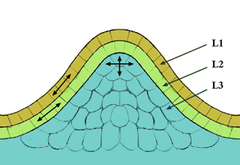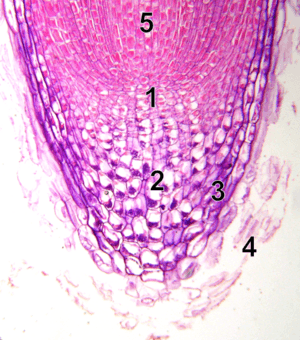Meristem facts for kids

The epidermal (L1) and subepidermal (L2) layers form the outer layers called the tunica. The inner L3 layer is called the corpus. Cells in the L1 and L2 layers divide in a sideways fashion, which keeps these layers distinct, whereas the L3 layer divides in a more random fashion.
A meristem is a tissue in plants made of dividing cells. They are in parts of the plant where growth can take place.
Plant cells which are differentiated generally cannot divide or produce cells of a different type. Therefore, cell division in the meristem is necessary to get new cells. This allows for the growth of tissues and new organs needed by the plant.
Meristematic cells have the same function for plants as stem cells have for animals. They are incompletely or not at all differentiated, and are capable of continued cell division.
The cells are small and protoplasm fills the cell completely. The vacuoles are extremely small. The cytoplasm does not contain plastids (such as chloroplasts, but they are there in rudimentary form ('proplastids'). Meristematic cells are packed closely together without intercellular cavities. The cell wall is a very thin primary cell wall.
Contents
Apical meristem
The apical meristem, or growing tip, is found in the buds and growing tips of roots in plants.
It begins growth of new cells in young seedlings at the tips of roots and shoots (forming buds, among other things). Specifically, an active apical meristem lays down a growing root or shoot behind itself, pushing itself forward. Apical meristems are very small, compared to the cylinder-shaped lateral meristems.
Primary meristems
Apical meristems may differentiate into three kinds of primary meristem:
- Protoderm – around the outside of the stem and develops into the epidermis.
- Procambium – just inside of the protoderm and develops into primary xylem and primary phloem. It also produces the vascular cambium, a secondary meristem.
- Ground meristem develops into the pith. It produces the cork cambium, another secondary meristem.
These meristems are responsible for primary growth, or an increase in length or height.
Secondary meristems
These meristems cause secondary growth, or an increase in width. There are two types of secondary meristems:
- Vascular cambium – produces secondary xylem and secondary phloem, which may continue through the life of the plant. It is what gives rise to wood in plants. Such plants are called arborescent. It does not occur in plants which do not go through secondary growth, that is, herbaceous plants.
- Cork cambium – gives rise to the bark of a tree.
Related pages
- Neil A. Campbell and Jane B. Reece Biology, 6th edition. Benjamin Cummings.
- Schoof et al. The stem cell population of Arabidopsis shoot meristems is maintained by a regulatory loop between CLAVATA and WUSCHEL genes. Cell 100: 635-644.
- Research on meristems: meristemania.org [1]
Images for kids
-
Complex leaves of Cardamine hirsuta result from KNOX gene expression
See also
 In Spanish: Meristemo para niños
In Spanish: Meristemo para niños






